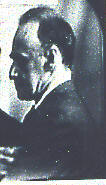 |
| HOME | GLOBAL | DISTRICTS | CLUBS | MISSING HISTORIES | PAUL HARRIS | PEACE |
| PRESIDENTS | CONVENTIONS | POST YOUR HISTORY | WOMEN | FOUNDATION | COMMENTS | PHILOSOPHY |
| SEARCH | SUBSCRIPTIONS | JOIN RGHF | EXPLORE RGHF | RGHF QUIZ | RGHF MISSION | |
|
The hedonistic 1920's is best remembered perhaps with an image of the flapper and was famously named by F Scott Fitzgerald as the 'Jazz Age'. It was also the age of 'Babbitt' - the epitome of the American middle-class or 'Booboisie' as Mencken called it.  Babbitt was Nobel Prize winner Sinclair Lewis’s famous masterpiece on the materialistic, conventional yet confused Rotarian camouflaged by the author in his Booster Club of Zenith City. What did the Boosters do? – They capitalized culture. Sinclair Lewis belonged to a group of radical, literary intellectuals that distrusted such new institutions yet had nothing but contempt for the past. To such critics, Rotarians had no notion whatsoever of culture. To such critics, Rotarians had no notion whatsoever of culture. Other critics included the famous Chicago trial lawyer Clarence Darrow, (right) the acid-tongued society critic Dorothy Parker (above) and the sophisticate editor of “Americana” Gilbert Seldes. (below)  Seldes described Rotary as: “These boy scouts of business do a dirty trick a day if they can get away with it, but it is a small trick…in the aggregate they provide an army of contented cows”. The typical Rotarian of this age seemed fair game for these caricatures. Rotarians, according to arch-critic H L Mencken (in his review of ‘Middletown’ The American Mercury, March 1929) were “well-fed, well-dressed, complacent and cocksure, he remains almost destitute of ideas”. Rotarians, paradoxically, came from the same backgrounds as their critics. The clubs did not appreciate being at the receiving end of sometimes nasty scorn. Some clubs such as the Rotary Club of Muncie, Indiana had an evening devoted to discussion of the Babbitt stereotype. It can be presumed that most Rotarians did not understand the criticism of their embryonic movement. They could contrast this vicious criticism with the grateful thanks from the organizations which Rotary Clubs were actively benefiting. The Great War had seen Government positively encourage such local volunteerism. War, however, also led to much disillusionment and the complacent club member was an easy target for its critics. Arthur Hobbes’s article in The Rotarian of November 1925 quotes Clarence Darrow’s attack on the movement: “They know life is worthwhile, and the reason they know it is because they can get money. You will find optimists in the Rotary Club…you will find them boasting and lying and stealing.” Rotary responded to the critics - many realised that certain club behaviour was "fair game". An example would be found in 'The Handbook of Entertainment for Rotary Clubs' published in 1919. Some of its suggestions included dressing initiates in diapers and having a member pretend to be a "woman speaker from Washington". The Rotary Club of London on its 25th anniversary readily admitted to having had "the Self-before-Service period". In this early period, London Rotarians were handed a small account book in which to record all transactions with other members. The Booster Club transcended national borders. At least Sinclair Lewis had the courage to address his victims. Speaking at the Rotary Club of Kansas City, members enjoyed his mimicry of the different types of Luncheon speaker, from the rambling journalist to the "he-man talking the he-language". Lewis then went on to annoy the Club members by lambasting into an attack against the Booster anti-culture. Lewis would mellow over the years in his attitude to Rotary. During his visit to Britain in 1928, Lewis admitted in an interview: "but I assert the growth of Rotary in Great Britain is more important for world tranquillity than all the campaigns of the reformers put together". After all, even the archetypal Babbitt had his good points - clearly Lewis loved his character. Sinclair Lewis was certainly less critical of Rotary than Mencken; his contempt for the movement was complete: "The first Rotarian called John the Baptist, 'Jack'". The Rotary movement became self-conscious of their image and inevitably got fed up with the ridicule as the early boyishness diluted over time. The 'Babbitt' Club member would and could be identified in their Clubs according to The Rotarian in February 1927. He was, in fact, the exception and not the rule. Cal Thomson New Direction in Social Welfare A new direction of Social Welfare Policy for the new post war Britain was first announced at a meeting of the Rotary Club of London in 1940. The Beveridge Report was first welcomed by Government Minister Ernest Bevin to enthusiastic Rotarians and signaled that Rotary was now a recognized community force to those in power. |
||||||